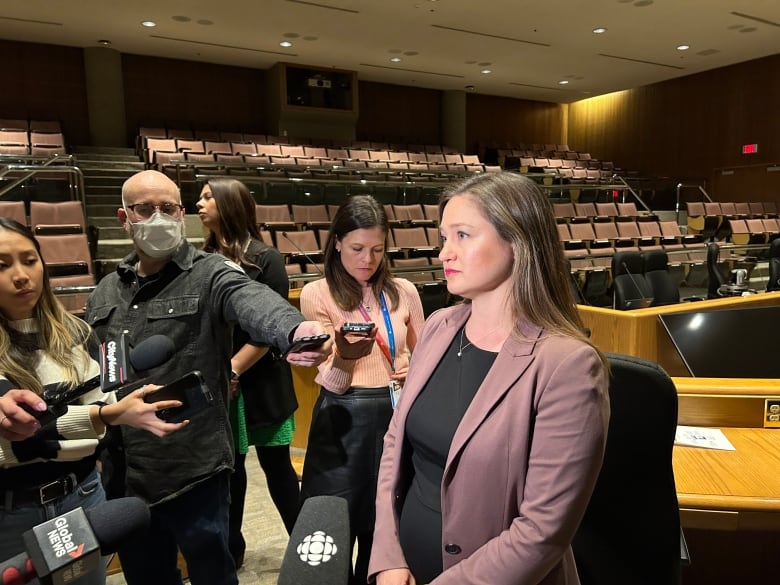Edmonton Public Schools can afford to add just four full-time teaching positions next year while it prepares for an influx of more than 3,000 new students.
Trustees repeatedly called the province’s education funding formula “broken” as they unanimously approved a $1.35-billion budget for the upcoming 2024-25 school year. It’s about five per cent larger than this year’s budget.
“This funding model is not in the best interest of students,” said trustee Dawn Hancock. “And I hope that our government sees it and makes a change.”
At issue is a provincial formula that uses a weighted moving average to determine how much school authorities receive for each student enrolled.
The education ministry uses school enrolment counts from the previous and current school years and a projected enrolment for the next school year to calculate per-student funding.
The approach was supposed to soften the blow for school divisions with declining enrolments, and temper the demands of school divisions experiencing hefty enrolment increases.
Edmonton Public Schools projects that 120,224 pupils will walk through the doors of its 214 schools by September 2024. That’s nearly 6,000 more than were enrolled in September 2023, or a 5.2 per cent increase. Half of those new students have already trickled into classrooms during the current school year.
Division superintendent Darrel Robertson said each year that enrolment surges, finances are stretched thinner. If the September projection materializes, Edmonton public’s enrolment will have grown by 18 per cent in five years.
The projected shortfall next year is equivalent to having 4,000 unfunded students, division officials said.
Class sizes will go up. And school leaders will have to make difficult choices about which students receive extra help in schools, Robertson said.
“Something needs to change,” he said. “… I think that we can all agree that we must prioritize the future of children across the province.”
The formula isn’t the only factor eroding the division’s spending power, officials told the board.
Insurance costs have more than doubled in the last five years. Utility costs are ballooning. And government grants to school boards do not account for these inflationary costs, chief financial officer Todd Burnstad said.
And although the province accounted for rising teacher salaries negotiated in collective agreements, it is not funding the increased benefit costs associated with those wage hikes, Burnstad said, setting the division back another $16 million.
Last year, under pressure from school boards grappling with overwhelming enrolment increases, Alberta’s education minister in December gave growing boards a collective $30 million to help them hire staff and make class sizes more manageable.
Burnstad said that funding allowed the division to hire around 224 more full-time teachers. Without a similar injection of extra cash this fall, schools will have to make do with the teachers they have, he said.

“That is a tough pill to swallow,” board chair Julie Kusiek told reporters after the trustees met Friday. “We will continue to do everything we can to support those teachers in our classrooms and support kids’ learning, but it is not where we want to be.”
Although the budget includes money for nearly 90 more educational assistants, budget documents say most of those positions are vacancies the division is struggling to fill.
Dwindling savings a ‘red flag’
The board plans to draw up to $16 million from its savings (called reserves) to balance the budget. Kusiek said the board is obligated to have reserves of at least one per cent of its operating funds on hand for emergencies.
As the division whittles away at savings to cover costs, it’s a “red flag” how close the division is to that threshold, she said.
Without reform to how schools are funded, the division may not be able to offer as many program choices in future years, she said.
In a statement, Education Minister Demetrios Nicolaides said the weighted moving average, plus supplemental grants for growing divisions, “achieves the best of both worlds” for both growing and shrinking divisions.
“I’m always open to talking with our school boards and making improvements as necessary,” his statement said.
Nicolaides said the United Conservative Party government has increased education funding to help accommodate the more than 200,000 people who moved to Alberta last year.
Nicolaides has previously said he has no plans to revisit the education funding formula.
The Edmonton Catholic School Board will consider its budget on May 29. Documents online show that division is also proposing to draw millions of dollars from its reserves to cover cost shortfalls, and note that provincial funding neglects to cover the costs of inflation or its expected 5.7 per cent enrolment increase.



